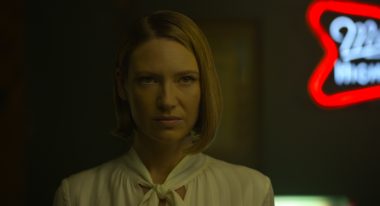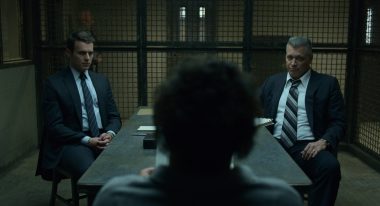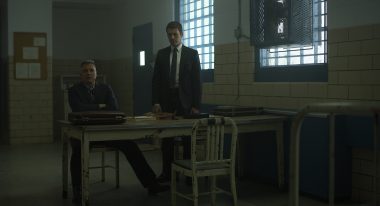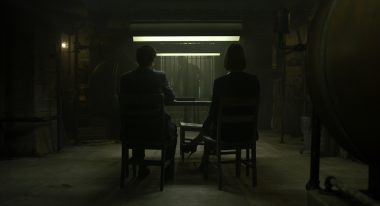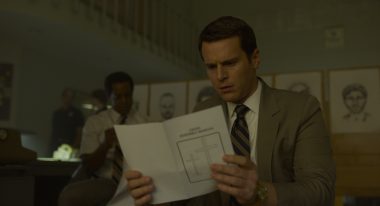 Back to selection
Back to selection
Shutter Angles
Conversations with DPs, directors and below-the-line crew by Matt Mulcahey
“If a Director Feels the Need to Move the Camera Simply to ‘Make It Interesting,’ It’s Likely an Indicator the Scene Itself Isn’t That Interesting”: DP Erik Messerschmidt on Mindhunter, Season Two
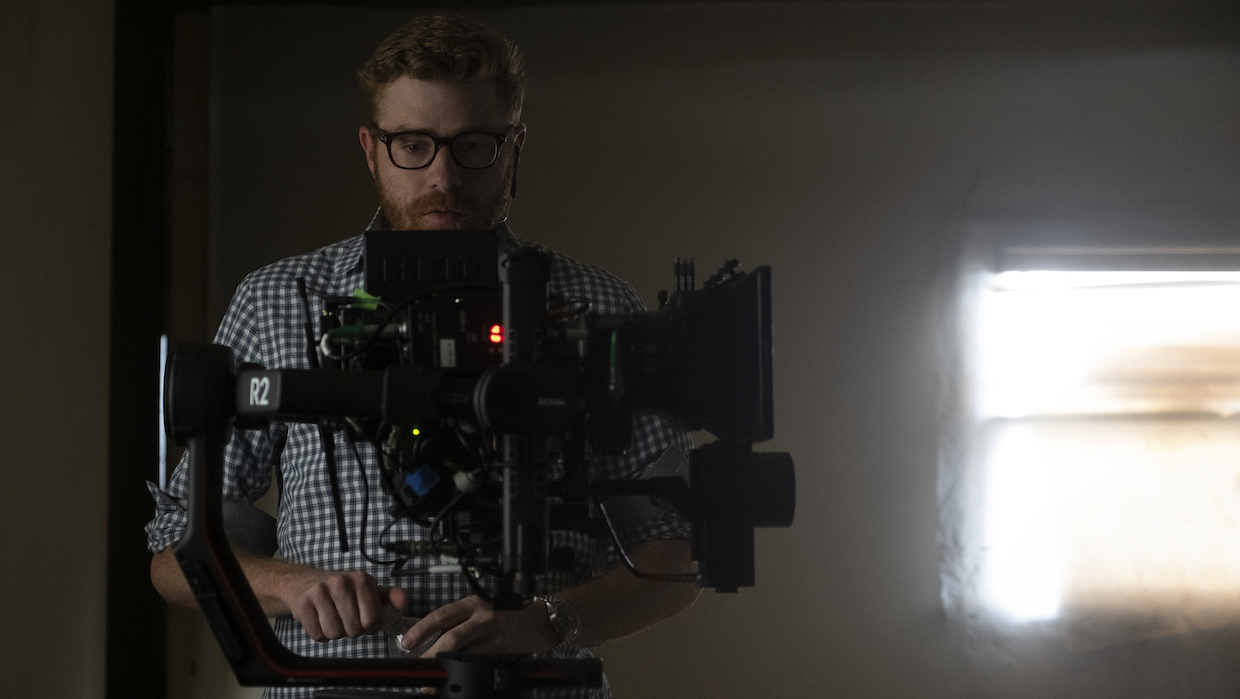 Erik Messerschmidt on the set of Mindhunter
Erik Messerschmidt on the set of Mindhunter When David Fincher transitioned from music videos to feature films in the 1990s, the descriptors “glossy,” “slick” and “stylized” were frequently affixed to his work. Those adjectives were often aimed as pejoratives, categorizing Fincher as a technical virtuoso who created shiny but hollow thrillers.
Watching the second season of Netflix’s Mindhunter—executive produced and partially directed by Fincher—the evolution of the filmmaker’s aesthetic is striking. As FBI profilers Bill Tench (Holt McCallany) and Holden Ford (Jonathan Groff) interview America’s most notorious serial killers, the camera rarely moves. Instead, it unobtrusively observes.
What hasn’t changed over the years is Fincher’s unwavering exactitude, exemplified by the show’s almost mathematically meticulous compositions. Cinematographer Erik Messerschmidt is the guardian of that precision, carrying season two’s restrained yet formal style across episodes directed by Fincher, Andrew Dominik (Killing Them Softly) and Carl Franklin (One False Move).
With season two now streaming on Netflix, Messerschmidt spoke with Filmmaker about the necessity of HDR monitoring, creating faux-anamorphic effects, and his hockey puck-sized secret weapon for eye lights.
Filmmaker: It’s been two years since season one of Mindhunter, which you shot on custom Weapon Red Dragons (nicknamed Xenomorphs). I guess it shows how quickly camera technology is changing, because since that time Red has gone to a universal DSMC2 brain and the Dragon sensor is only in their lowest-cost camera. Now the Monstro 8K VV and the Helium 8K S35 are Red’s top-of-the-line offerings. Did you change cameras for season two?
Messerschmidt: For season two we switched to Red’s Helium sensor, shooting in 8K 2:1 with 8:1 compression. Out of the 8K raster we framed for a 6.5K extraction area, which left room for stabilization in post. We did extensive lighting, color and workflow tests prior to the decision to switch camera sensors and ended up loving the results of the Helium. We found the noise floor to be substantially lower, the color fidelity to be better and the sensitivity to be higher than the Dragon.
Filmmaker: Did you have any additional custom Xenomorph tweaks for the new cameras?
Messerschmidt: For season two Red built us a new model of the Xenomorph dubbed the Mark II. The new body included the DSMC2 brain with the Helium sensor. It was upgraded with redesigned cooling, integrated lens motors and the new Teradek Bolt video transmitters.
Filmmaker: We didn’t get around to talking about HDR in your season one interview with Filmmaker. Tell me about that process on season two.
Messerschmidt: For season two, we knew we were going to finish in Dolby Vision HDR from the beginning. With that in mind, and taking what we had learned the first season, I did extensive testing prior to our preproduction period to explore how it might affect my lighting and exposure. I worked with the DI colorist, Eric Weidt. He and I developed a color pipeline and on-set monitoring system that allowed us to monitor in HDR using an ACES workflow in Dolby PQ gamma and Rec.2020 color. For us, the setup worked great and I’m really proud of what we put together. We settled on the Canon range of HDR field monitors with the DP-2420 as our primary monitor. If one is going to finish in HDR, I believe it’s absolutely essential to monitor in HDR on the set, as HDR directly affects lighting ratios and exposure. During the DI of the first season I found we were stretching our highlights out to fill the added space in the HDR gamma space, which sometimes led to odd-looking practically lit night interiors. That is because, in most cases, I was not making full use of the sensor’s contrast, because my lighting choices were informed by an SDR monitor and waveform. Conversely, when monitoring in HDR I found I was less concerned with highlight detail, because I could see exactly where my exposures fell relative to the gamma of the final finish, and therefore was able to use more of the sensor’s dynamic range. It meant much less fill and more “exposure to the right” while still feeling confident I could work in the tow of the exposure range for most of the scene’s action.
Filmmaker: Did you use the Leica Summilux-C lenses again for season two?
Messerschmidt: We continued to use the Leica Summilux-C series and again found them to be a fantastic choice. Most of Mindhunter was shot on the 29mm, 40mm and 65mm lenses.
Filmmaker: Fincher famously isn’t a fan of anamorphic, but Mindhunter season two has some lens characteristics traditionally associated with anamorphic lenses such as horizontal flares and barrel distortion on the edges of the frame. How did you achieve those effects on spherical lenses?
Messerschmidt: We wanted Mindhunter to have aesthetic characteristics reminiscent of anamorphic but without the negative drawbacks those lenses often saddle us with. As a result the barrel distortion, chromatic aberration and horizontal flares were added in post with the help of our VFX team. It was great for me because we could adjust those effects to taste in the DI, which was particularly helpful when it came to distortion. We spent a lot of time on Mindhunter with composition and blocking, so getting the lens distortion just right was a huge part of getting the shot to look as good as possible in the end.
Filmmaker: One of the complaints you’d often hear about Red cameras versus Alexas was that the skin tones for the former weren’t as flattering, particularly in the days of the pre-IPP2 color science. In Mindhunter, you’re often dealing with skin tones in less-than-pleasant colors. Tell me about your approach to lighting actors in close-ups when you’re in a location with sickly greens or yellows. Are you using RGB-capable LEDs to dial in specific hues?
Messerschmidt: I often worked with mixed color temperatures because I believe the lighting should be motivated from the set. Mixes of fluorescent, sodium vapor, mercury and neon were common sources, but I wouldn’t describe any of them as “sickly” or “less than pleasant.” I take the natural lighting of every set and historical context into consideration before deciding a lighting approach for each scene. It is also, of course, intrinsically important to consider how our lighting and color palette supports the themes, atmosphere and story of the project. David and I take the color palette very seriously, with tremendous purpose and careful planning. Our production designer Steve Arnold and I spent an enormous amount of time discussing paint colors, lighting fixtures, windows and practical lights in every set, specifically in terms of how those sets would exist in reality. Our color palette is supported by costumes, set design, lighting and ultimately the grade. Lighting is just one part of a holistic aesthetic approach to the look of the show.
In terms of working practice, I didn’t use any “colored” light per se, with the exception of some Sodium Vapor colored light in distant backgrounds. In most cases we were working with natural “white” light, endeavoring to use full spectrum sources. In scenes predominantly lit with incandescent lamps the light is warmer. In office scenes lit with fluorescents the light is slightly cooler and greener. Day interiors were either overcast and blue or brightly lit with hard sunlight. It all depends on the context of the scene, the location or set. Lighting is all story and location driven for me.
In terms of skin tones on the Red camera, specifically, I haven’t found any issues getting the color rendition and fidelity I want out of the camera. We found we had tremendous room in the DI to push the color around as we saw fit. We used the “skin tone” internal OLPF with great success.
Filmmaker: You always seem to get a little gleam of an eye light in the show’s close-ups, even in the darkest of scenes. Do you have a go-to method for subtle catchlights?
Messerschmidt: I try to stay away from traditional “smart side key” lighting in dramatic work, as that method often feels a little too “lit” and unnatural for my taste. A lot of the scenes in our show take place in fluorescent-lit offices and interrogation rooms, so the light is predominantly motivated from above. I use a very small LED eye light we call “the puck,” because it’s the size and shape of a hockey puck. In shots where the key light isn’t in the actor’s eye line I use it to add a little catchlight. With this catchlight I can expose the actor’s face darker, as long as we read the eyes. I think it’s very important, especially in dramatic scenes, to see the actor’s eyes and their intensity.
Filmmaker: Tell me about the scene in episode seven where Holden is racing to place a memorial cross at a church in Atlanta. It’s one of the few scenes this season that feels stylistically separate from the rest.
Messerschmidt: In the DI, Fincher, our colorist Eric Weidt and I experimented with that scene a lot. The scene is based on one of the many “STOP” marches that community members staged during the investigation [into the child murders] in Atlanta. We didn’t feel like the scene was as effective when it was presented strictly in our show’s visual style, and David liked the idea of making some of the footage feel like stock footage of the actual event. We manipulated some of the footage in the grade and landed on that effect. I think it worked pretty well.
Filmmaker: I want to talk about your general approach to shooting the serial killer interviews. How many cameras are you typically using?
Messerschmidt: Most of the interview scenes were shot with two cameras, with an occasional third camera used in very heavy dialogue scenes. I usually operated the third camera.
Filmmaker: What are your rules for camera movement? There are often traveling shots to get Holden and Tench into the interview area, but once the offender sits down the camera rarely—if ever—moves.
Messerschmidt: As filmmakers we use the camera, and specifically the content of the frame, to indicate what we want the audience to understand, [to highlight the elements] that we are saying are important. With Mindhunter we took composition and blocking very seriously. If the shot is about space and environment we might move the camera. If it’s about showing our characters experiencing a space or learning new information, we’ll use POV. If it’s about dialogue and the characters’ experience of a dramatic moment, we usually kept the camera objective. We were very careful in our use of POV and perspective. The second the audience is aware of the handheld or operated camera, I think they start to assume point of view and it affects the perspective from which they experience the scene. So, we were careful. We only moved the camera when we felt it was absolutely necessary or thematically appropriate. It was something we did only with tremendous purpose. I think if a director feels the need to move the camera simply to “make it interesting,” it’s likely an indicator the scene itself isn’t that interesting.
Filmmaker: How do you plan your coverage for those scenes? The interviews are covered from a lot of angles, some just slightly tighter or looser than another similar shot. Do you storyboard or do detailed shotlists?
Messerschmidt: It depends on the director. For our dialogue scenes, many of which are very long, we would usually rehearse, sometimes days in advance, and discuss our coverage plan after we had the blocking worked out. It’s difficult to storyboard dialogue scenes because a lot of the shot structure and design depends on performance and staging. It’s particularly difficult to predict from the script alone the off-dialogue looks between actors and the nuanced performance beats. A scene might have one or two “trick shots” used in the apex of a dramatic moment, but for the most part we stuck to very formal coverage—a mix of overs, profiles and tight eye line close ups. David asks the actors to be very structured and consistent with their movement and choreography. If an actor chooses to smoke, for example, it’s important that they take a drag at the same time in the scene in each take so there is editorial continuity in the coverage. We shoot with primes on the show, restricting ourselves to three or four focal lengths, which also contributes to the formality and consistency of the coverage. Carl Franklin did storyboard most of the action scenes in his episodes. Scenes such as the car chase and cross running were entirely storyboarded, mostly as a communication tool for all the departments as they were logistically complicated scenes.
Filmmaker: Do you run most of the angles all the way through the scene? Or if you have a super wide or a super tight that you know might only be used for one or two beats, do you just pick up specific sections of the scene?
Messerschmidt: That is, of course, the director’s choice, but in general I would say all the directors usually ran the entire scene for each setup, often at the actors’ request. You never totally know what will become useful editorially and sometimes there are nuances in the performance that appear when you least expect it. I think it also helps the actors to work things out. When you run the wide master several times all the way through it’s a good way for the actors to hone their performance and work out the physical action, their use of hand props, pauses and pacing. When we would get one or two prints of the wide masters, whether they were developing shots or static frames, David would say, “OK, we’ll match to that.” Then we would know where the scene’s beats were and how we needed to support them with the camera and the subsequent coverage. It’s a nice way to work.
[Below, Erik details the lighting set ups behind a few of Season 2’s most memorable interview scenes.]
David Berkowitz
Messerschmidt: For Berkowitz we wanted the room to feel cool and uninviting. Steve Arnold built a beautiful set where the table is surrounded by a giant cage. It gave us great composition opportunities. We built a large toplight in the center of the room, which I filled with LEDs. We shot some tests in there during the pre-light and David and I liked the color contrast with the cooler toplight and warmer light in the background. We also tested the light with [Berkowitz actor] Oliver Cooper’s prosthetic makeup to make sure we liked the outcome.
Filmmaker: Is it hard to keep track of the eye lines in these scenes? There are moments where you’re intentionally crossing over the 180-degree line.
Messerschmidt: I would say we’re generally pretty dogmatic with screen direction on the show. I think when you have supporting screen direction for each dramatic interaction it makes the cutting sequence subliminally cleaner and smoother. We often shot the interviews from multiple sides of the line, which gives the editors the option to deliberately cross the line in a specific part of the cutting sequence. I think it’s an interesting technique to manipulate the audience’s experience, even if it’s a very nuanced effect.
Charles Manson
Messerschmidt: David and Steve Arnold thought it would be interesting if Holden and Tench interviewed Manson in the prison infirmary. The location they found was in a decommissioned prison in Pennsylvania that we used quite a bit in the show. The scene is predominantly lit with cool, soft daylight motivated from the windows. It took two or three days to shoot the scene, so we built tents outside the windows and used Litegear LiteTiles to generate the soft light, as we would be unable to control the natural light across the entire shooting time.
Paul Bateson
Messerschmidt: Paul Bateson was lit with fluorescents, as many of the scenes in the show are, but this time we hung them very low so they were just above the tabletop. This meant we could keep the background dark as it fell off against the brighter table light.
The Atlanta Child Murders Task Force headquarters
Messerschmidt: I love this set. Steve Arnold built a beautiful set on stage that was modeled after the real task force headquarters (the Atlanta Police Department) set up inside an old car dealership. The set had two-story glass windows, which Steve painted with an eggnog-colored white latex paint. For daytime scenes our gaffer, Danny Gonzalez, pushed two or three 20K Fresnels through the windows, which gave a beautiful oak tag colored soft light. For night we let a little sodium vapor light hit the windows but motivated most of the light from tabletop fluorescents, which we fitted with cool white tubes. It was a fun set to light.
Matt Mulcahey works as a DIT in the Midwest. He also writes about film on his blog Deep Fried Movies.
